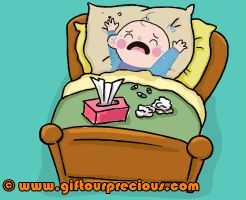The First Time My Baby Has a Cold
As parents, we are most worried when our child falls sick, especially when they are baby and can’t communicate to us verbally how they feel, only able to cry and get our attention.
We literally panicked when our baby Leeroy caught a cold for the first time and googled numerous sites to research for more information on what are the symptoms and the treatment. Hope this article is useful to you.
What is common cold?
Common cold, also known as upper respiratory infections, is caused by small infectious organisms know as viruses, which are much smaller than bacteria.
Common cold is extremely infectious and make the baby or the child sick by infecting the throat, nose and sinuses.
It is not unusual for a child to have an average of 8 to 10 cold a year. A baby can have an average of about 8 cold before they reaches the age of 2 years old.
The good news is once the infant or child is exposed to the cold virus, he will be immune to the virus, so the infant or child will tend to get less infection from cold as they grow older.
How is common cold transmitted to the baby or child?
Common cold is extremely contagious, especially during first 2 to 3 days of showing the symptoms.
The infant or child can get cold virus when he breathe in the airborne virus when someone cough or sneeze or when the infant or child touches infected surfaces.
A cold virus can stay on surface of objects for several hours, when the infant or child touches the infected surfaces, and subsequently rub his eyes, or touches his nose and mouth, cold virus is transmitted.
Below are some common ways that an infant or child can be infected with the common cold virus.
- When infected older children, siblings or adults cough or sneeze near the baby or child, he will inhale the airborne virus from the droplets in the air.
- When the child is placed in day care with other infected children, he may get the cold virus when the children play together where they will have opportunity of touching each other with their contaminated hands.
- When caregivers from day care changes diaper for the children, if they do not disinfect their hands between diaper changing, they may spread the cold virus from an infected child to other healthy children.
What are the Symptoms?
Upon infection, your child may take 1 to 3 days before showing the symptoms of cold. Some of the signs and symptoms of common cold in infants and young children are as follows.
- Cough
- Sneezing
- Watery eyes
- Congested nose
- Clear, runny discharge
- Mild fever of less than 100.4 degrees Fahrenheit or less than 38 degrees Celsius
** A common cold can also develop into more complicated illnesses such as ear infection, pneumonia and croup. Please seek immediate medical attention if complication arises.
For more details of the signs and symptoms of common cold and its complications, please refer to Cold Symptoms in Babies and Young children
What are the treatments for cold?
Bad news is there is no cure for common cold. Medicines are used to relieve the symptoms of cold, while the child’s body defence systems work its way to fight the virus, and repair the damage done.
Below are some ways you can help to relieve your child of the sickness.
- Over-the-counter (OTC) cold medicines (which do not require doctor’s prescription) should not be given to child below 2 years old unless doctor has been consulted. OTC medications can have severe potential side effects such as convulsions and rapid heart rate. FDA (Food and Drug Administration) advises against the use of cough and cold medicines for children younger than age 2.
- It is best to consult a doctor or pharmacist before giving children under 12 years old OTC medications. Parents please read medication instructions carefully and give dosage according to instruction. Some OTC medicines are decongestants (to relieve congestion in nose), antihistamines {to relieve blocked and running nose), antitussives (to relieve dry cough), expectorants (to relieve wet cough) and antipyretics (to relieve headache and reduce fever).
- Constantly take note of your child’s temperature. For fever higher than 38.5°C, acetaminophen, such as Panadol, Tylenol or Tempra, or Ibuprofen, such as Advil and Motrin (for children more than 6 months old only), can be given to relieve fever. Acetylsalicylic acid such as Aspirin, or any cold medicine containing it, should not be given to children younger than 18 years old as it can lead to Reye’s Syndrome, which can cause brain, kidney and liver damage.
- For baby who has trouble drinking or nursing due to nose congestion, parents can use a suction bulb to clear the mucus from the nose, or use saline nose drops or spray to relieve the baby from the mucus.
- Keep your child comfortable, such as placing a cool mist humidifier or hot steam vaporizer (make sure it is out of reach of the child as it may cause burns), this will help the child to relieve stuffy nose.
- Allow your child to sleep slightly upright if possible. Letting your child sleep in a slightly upright position allows the child to breathe more easily during sleep.
- Ensure the baby or child rest more.
- Ensure the baby or child has a lot of fluid.
- Ensure the child has small nutritious, well balance diet.
Prevention measures for Common Cold
Below are some ways that we parents can help to prevent our child from getting common cold.
- Proper hygiene and cleanliness. Keep toys and common household areas clean. Inculcate children to have good habit of washing or sanitizing hands often. Get everyone in the house to cough or sneeze into a tissue or wear a mask if they are not feeling well.
- Keeping away from people with cold. Keep the child away from infected people. Avoid close and prolong contact with infected people.
- Get enough sleep and have well balanced diet. It is important for young children to have plenty of sleep and to eat healthily, lack of sleep and improper diet will have negative impact on immune system.
Generally, as long as there are no complications, common cold in children are usually not serious and will normally recover by itself within 14 days or so.
http://www.ncbi.nlm.nih.gov/pmc/articles/PMC2722603/

